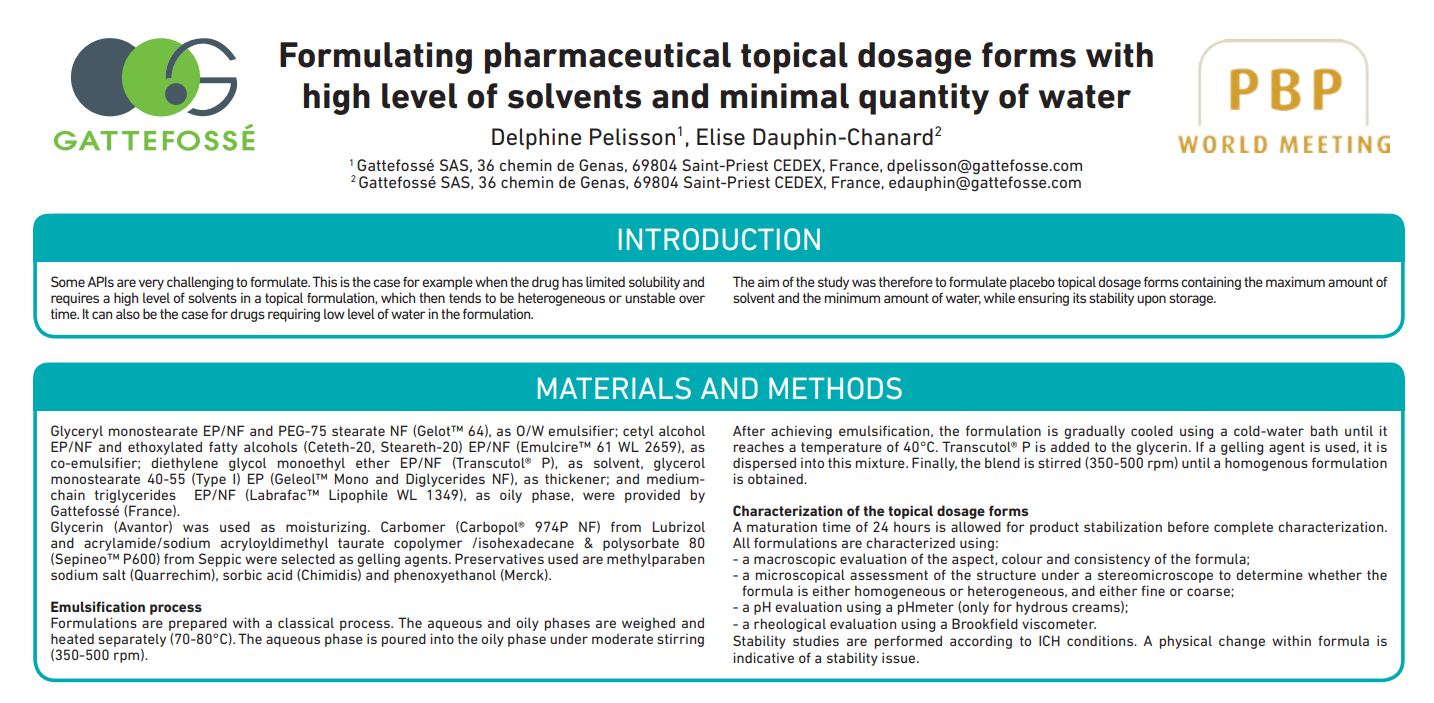Formulating pharmaceutical topical dosage forms with high level of solvents and minimal quantity of water

Poster presented by Gattefosse and RCPE at the 14th World Meeting on Pharmaceutics, Biopharmaceutics and Pharmaceutical (PBP) Technology, 18 – 21 March 2024, Vienna, Austria:
INTRODUCTION
Some APIs are very challenging to formulate. This is the case for example when the drug has limited solubility and requires a high level of solvents in a topical formulation, which then tends to be heterogeneous or unstable over time. It can also be the case for drugs requiring low level of water in the formulation.
The aim of the study was therefore to formulate placebo topical dosage forms containing the maximum amount of solvent and the minimum amount of water, while ensuring its stability upon storage.
MATERIALS AND METHODS
Glyceryl monostearate EP/NF and PEG-75 stearate NF (Gelot™ 64), as O/W emulsifier; cetyl alcohol EP/NF and ethoxylated fatty alcohols (Ceteth-20, Steareth-20) EP/NF (Emulcire™ 61 WL 2659), as co-emulsifier; diethylene glycol monoethyl ether EP/NF (Transcutol® P), as solvent, glycerol monostearate 40-55 (Type I) EP (Geleol™ Mono and Diglycerides NF), as thickener; and medium-chain triglycerides EP/NF (Labrafac™ Lipophile WL 1349), as oily phase, were provided by Gattefossé (France).
Glycerin (Avantor) was used as moisturizing. Carbomer (Carbopol® 974P NF) from Lubrizol and acrylamide/sodium acryloyldimethyl taurate copolymer /isohexadecane & polysorbate 80 (Sepineo™ P600) from Seppic were selected as gelling agents. Preservatives used are methylparaben sodium salt (Quarrechim), sorbic acid (Chimidis) and phenoxyethanol (Merck).
Emulsification process
Formulations are prepared with a classical process. The aqueous and oily phases are weighed and heated separately (70-80°C). The aqueous phase is poured into the oily phase under moderate stirring (350-500 rpm).
After achieving emulsification, the formulation is gradually cooled using a cold-water bath until it reaches a temperature of 40°C. Transcutol® P is added to the glycerin. If a gelling agent is used, it is dispersed into this mixture. Finally, the blend is stirred (350-500 rpm) until a homogenous formulation is obtained.
Characterization of the topical dosage forms
A maturation time of 24 hours is allowed for product stabilization before complete characterization.
All formulations are characterized using:
- a macroscopic evaluation of the aspect, colour and consistency of the formula;
- a microscopical assessment of the structure under a stereomicroscope to determine whether the formula is either homogeneous or heterogeneous, and either fine or coarse;
- a pH evaluation using a pHmeter (only for hydrous creams);
- a rheological evaluation using a Brookfield viscometer.
Stability studies are performed according to ICH conditions. A physical change within formula is indicative of a stability issue.
RESULTS AND DISCUSSION
Gelot™ 64 and Emulcire™ 61 WL 2659 were selected since they enable the emulsification of hydrophilic solvents, with highest stability properties compared to the other emulsifiers tested (internal studies). These emulsifier and co-emusifier, at a ratio 1:1, create shiny and homogeneous formulation, with pleasant texture. A previous study was carried out with the incorporation of 40% Transcutol® P.
However, the objective of incorporating the highest concentration of Transcutol® P should result in a final dosage form adapted to patient use: texture adapted to sampling, ease of application, reduction of greasy sensation/after-feel and rapid adsorption.
Since an ointment is defined as a semi-solid preparation, in which more than 50% of the content is hydrocarbons, polyols or waxes-based; less than 20% is dispersed solid and at least 20% is water: all formulations developed are hydrous emulsions2. Depending on the gelling agent used, the proportion of oily phase, the texture and the amount of Transcutol® P are variable.
Without gelling agent, the DPE 80 and DPE 153 formulations allow the incorporation of 25% of Transcutol® P with high stability capacity (6 months at 40°C, even 50°C for emulsion DPE 80). The water percentage can be reduced by increasing the quantity of glycerin: thus, the DPE 153 cream displays the lowest water percentage (22.90%).
Up to 30% of Transcutol® P can be added into the cream, when using 10% of Gelot™ 64 and Emulcire™ 61 WL 2659 (1:1) in combination with Sepineo™ P600. The formulation DPE 108 provides the highest viscosity, but is, however, still easy to apply. For a lighter texture, the formulation can be simplified by using only Gelot™ 64. In this case, 25% of Transcutol® P can be incorporated in the emulsion. The balm is an alternative for very water-sensitive active ingredients. In this case, up to 25% Transcutol® P could be incorporated (DPE 125 and DPE 156). The textures obtained can be modulated depending on the ratio of Gelot™ 64/Emulcire™ 61 WL 2659 used, in accordance with the surface to treat.
(click picture to enlarge)

CONCLUSION
Transcutol® P has strong solubilization capacity for both lipophilic and hydrophilic APIs. Therefore, it is ideal for poorly soluble molecules. When higher concentration of solvent is required, it can be difficult to develop stable topical dosage forms.
This study provides guidelines to emulsify up to 30% of Transcutol® P, with lowest amount of demineralized water. For highly hydrosensitive drug, two balm formulations have been proposed containing up to 25% of Transcutol® P.
See the full poster on “Formulating pharmaceutical topical dosage” here
(click the picture to download the poster)
Source: Delphine Pelisson, Elise Dauphin-Chanard, Gattefossé, www.rcpe.at, poster “Formulating pharmaceutical topical dosage“, PBP 14th World Meeting, 18 – 21 March 2024, Vienna
Do you want to see more posters of the PBP World Meeting 2024 in Vienna?


